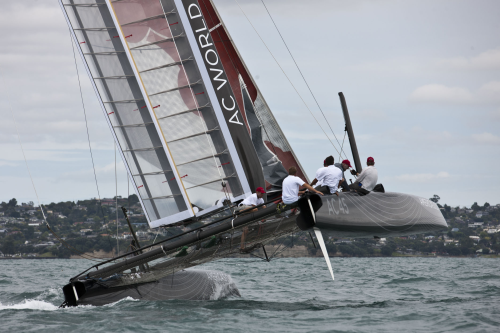
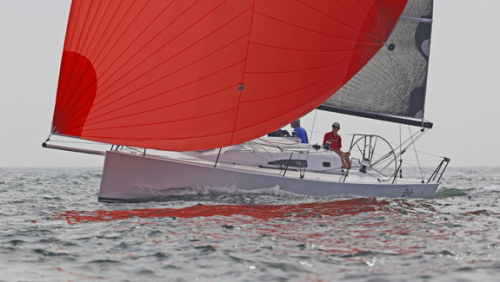
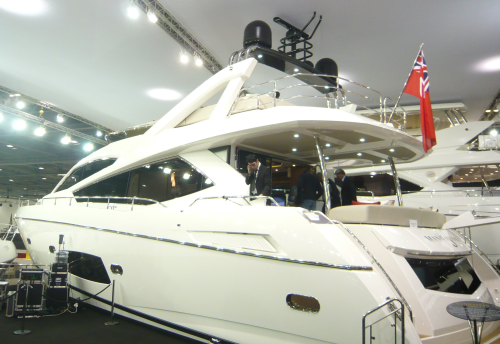
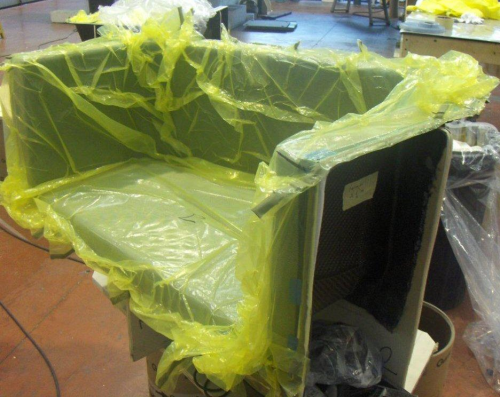
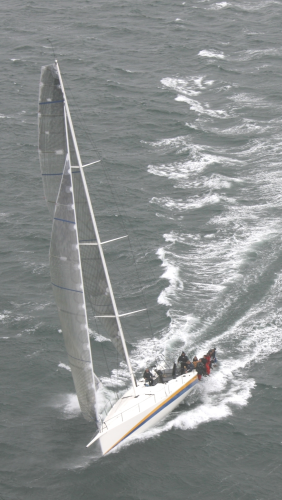
Using high performance fibres that are already impregnated with resin is, say the proponents of prepregs, a sure way of building consistent quality into fibre reinforced plastic (FRP) products. Aircraft builders became convinced some time ago, but constructors of marine craft have followed suit as customers for premium yachts and some commercial craft seek top performance with structures that are exceptionally light, stiff and strong.
Prepregs have become a primary means to achieve this winning combination. These materials avoid the nagging inconsistencies associated with traditional FRP processing, especially the variable quality achieved by different laminators working on different days in different conditions with non-consistent material mixes. Bulk material manufacture under controlled factory conditions ensures that prepregs provide high and consistent fibre-to-resin ratios, along with even fibre wet-out during cure. For their part, fabricators are happy to abandon messy wet lay-up and spray-up operations together with their associated volatile emissions. They can worry less about resin viscosity since this is controlled as a function of the cure, while concerns over precise mixing of catalyst, accelerator and resin are avoided. Less resin is wasted and laminators operate in a cleaner and healthier working environment. Multilayer materials simplify the lay-up process because some of the lay-up has already been done and is inherent in the material.
Although carbon epoxy composite has become a marine industry mainstay in recent years, glass and aramid prepregs are also available, with polyester, vinyl ester or epoxy resins. In the past, prepregs had to be cured under pressure at high temperature – typically 175°C for aerospace structures – and this held back any penetration into the marine sector, where most constructors have neither the desire nor the finance to acquire and operate large autoclaves. However, the advent of materials that cure at lower temperatures and with vacuum bag consolidation, with only minor sacrifice of performance and quality in the cured product, made prepregging viable for high-end marine craft constructors. Low temperature prepregs now available can be cured at atmospheric pressure (vacuum bagging) at temperatures as low as 65°C, avoiding the need for autoclaves and reducing energy needed during the cure cycle. Resin chemistry manipulation has made this possible. Prepreg suppliers use resins from various manufacturers, though some have developed their own bespoke formulations to meet specific customer needs.
Top echelon
Prepregs first migrated into the top echelons of competitive yachting via such prestigious events as the America's Cup. At this exalted level, nothing less than the highest structural performance will do. As part of the engineering arms race that this has precipitated, a few manufacturers at the leading edge have bucked the marine sector trend by investing in autoclaves.
One notable example is Hall Spars and Rigging, a producer of spars and parts for some of the world's fastest sailing craft, including the current holder of the America's Cup, BMW Oracle. Eric Hall had dreamed of making aerospace-grade advanced composite masts since the company was founded, as Hall Spars, in 1980. A major step came a decade later when wet lay-up was abandoned in favour of oven-cured prepregs. The oven was replaced with an aerospace quality autoclave in 1992 when Hall Spars was chosen to build booms, spinnaker poles and other items for the America 3 America's Cup syndicate. Masts for a series of top racers followed and when the Swiss team Alinghi won the America's Cup in 2003, they owed their victory in part to Hall's extraordinarily light and strong carbon prepreg mast, boom, spinnaker pole and reaching strut. Alinghi capped this victory with another America’s Cup win in 2007.
Hall is already involved with the next America’s Cup series, due in 2011-2012, having been chosen to build the tough autoclave-cured carbon tubes that form the crossbeams and other parts for strikingly fast AC45 carbon catamarans being built as precursors to full-scale 72 ft craft that will sail the actual Cup races.
Hall produces seamless masts and tubes by laying continuous unidirectional carbon fibre prepreg round an aluminium male mould. An autoclave cure at 120°C and 6 bar pressure follows, the aluminium mandrel being removed late in the cycle. Each layer of carbon is carefully compacted during lay-up to ensure that, even in thick-walled tubes, the laminate is wrinkle-free. As a result the outside surfaces are sufficiently smooth not to require any weight adding filler before a clear-finishing coat is applied. In the late 1990s, Hall installed a massive new autoclave able to accommodate spars up to 46 m long that it was by then building for superyachts. Even this was outgrown as Hall went on to produce ever longer masts, including a 59.5 m long seamless carbon spar built for the Wally 148 Saudade.
In the latest high-tech elaboration, Hall's single-piece seamless mast construction method has been combined with carbon nanotube technology developed by the Zyvex Performance Materials. Zyvex’s Arovex material is produced by mixing carbon nanotubes into the resin which is then combined with carbon fibres to create a prepreg. Fortifying the resin with nanotubes enhances the strength of the finished product without the need for extra reinforcing fibres or the expense of higher-modulus carbon. The new J/111 sailboat from J/Boats is an early platform for the Hall/Zyvex carbon nanotube mast technology.
Prepreg does not have to be a fabric; it can, as exemplified by another spar maker, Selden Mast, be pre-impregnated wound fibre. Selden contends that its customised filament winding system avoids the overlaps and crossovers, along with associated resin build-up, evident in cloth-based products. Its use of carbon is said to be efficient and fibre can be laid at any angle. Company naval architect John Butler is enthusiastic about the weight saving, quality enhancing capabilities of this approach and believes that given the avoidance of all wet lay-up, the accuracy and flexibility of the delivery system is second to none. He also asserts that because prepreg fibre requires less resin than a cloth, weight of the final product is still further reduced.
Designers pay great attention to minimising the weight of the rig in a performance sailboat because reduced weight aloft means that, for a given displacement, more weight can be added to the bulb keel so that righting moment under a press of sail is enhanced. Hence innovations in high-tech carbon masts are being matched by those in the standing rigging that supports them. Whereas stainless steel rod rigging once prevailed, racing yachtsmen now lust after carbon and a proportion of this starts as prepreg. Swiss company Carbo-Link GmbH, for example, produces innovative tension members for giant crawler cranes and other civil engineering items as well as yachts, using prepregs of its own manufacture. Starting with carbon tows, it impregnates these while laying out the fibres in a flat layer. The resulting prepreg tapes are then bound into a circular consolidated carbon rod, which is normally cured in a long oven.
However, because of the difficulty of coiling solid rod for transportation, the company has also developed a way of curing the rod on site so that it can be coiled and transported with the resin in its pliable Beta state. Once on site, in a process known as Ohmic curing, Carbo-Link specialists cure the stay by passing an electric current through it. Heat generated as a result of the electrical resistance cures the resin matrix. The technology has benefitted top racers including America's Cup and Volvo Ocean Race yachts.
Primary structure
Prepreg can also save weight in the primary structure. A growing number of production boatbuilders, inspired by the high-end racing sector and in response to customer demand, are moving into carbon construction for hulls and decks. Though wet lay-up is still in widespread use, many fabricators covet the advantages of newer processes. Transitioning to a new manufacturing system is a big step and producers tend to try out the technology on a pilot scale before proceeding further. UK-based luxury motor yacht builder Sunseeker International Ltd exemplifies this approach.
An early foray into prepreg was made in 2009 when Sunseeker worked with composite materials and solutions provider Amber Composites Ltd to develop an ultra-light sledge that could help a team of injured servicemen come back down Mt Kilimanjaro after climbing the mountain in a Help for Heroes (charity) expedition. The carbon/Kevlar sledge was built using Amber's 8020 prepreg technology. On the back of this project, Sunseeker started to look at introducing more advanced composites into its yacht build programme. This resulted, in 2010, in a first prepreg part for a Sunseeker yacht, a Manhattan 63.
A companion hatchway normally constructed in glass reinforced plastic (GRP) was considered to be rather heavy and Sunseeker was keen to have a lighter version. A prototype made at Amber using its 8020 system and shown to the yacht builder's development team offered a 10% weight saving, but the team wanted further reduction and the possibility of a carbon finish for cosmetic benefit. A second hatch was made using Amber's E520 out-of-autoclave system which can be oven cured at 90°C. The new composite structure was made up of two symmetrical skins sandwiching structural foam core. Each skin comprised a 245 g/m2 2 x 2 twill carbon surface ply and three layers of 245 g/m2 twin tack material, the outside being coated with a clear UV-stable lacquer finish.
First offered as an option at the 2010 Southampton Boat Show, the new hatch has proved popular with clients. Subsequently, the skin laminate has been modified by the introduction of a 400 g/m2 ply in place of two of the 245 g/m2 layers in order to reduce lay-up time. The end solution has halved the weight of the original GRP hatch.
Since then, Sunseeker has adopted carbon prepreg for a significant part of the primary structure of the latest addition to its flybridge range, the Manhattan 73. This part is a lateral 'hoop' that provides strength and stiffness at a high point in the superstructure, where weight saving is particularly desirable. The hoop is a shaped hollow beam that is moulded in two halves in matched female vinyl ester moulds. Total surface area is 9 m2. Again, a symmetrical foam sandwich form was adopted, though with stronger skins made up of a 245 g/m2 surface ply over a 650 g/m2 prepreg and a 245 g/m2 inner ply. A high-specification structural foam is used to maximise rigidity and strength.
Amber Composites worked with the yacht builder to develop the optimum lay-up and processing details. The Amber E520 system materials are laid up by hand, vacuum bagged and de-bulked before the composite is subjected to an 8 hour oven cure at 90°C. At 25 kg, the carbon hoop is about a quarter the weight of the previous GRP version. The Manhattan 73 also has a carbon companionway hatch.
Sunseeker, a builder that has long remained faithful to GRP and manual lay-up, albeit lately with carbon additions and added vacuum infusion, is experiencing the same customer desire for the perceived 'sexiness' of carbon composite as other prestige yacht builders and its R&D team is working with Amber on further prepreg developments.
Today a number of performance craft designers and owners are opting to have the entire boat made from weight-saving composites. As a result, there is growing use of prepregs in the manufacture of the primary hull and deck monocoque. Iconic constructor Wally Yachts, for instance, is well versed in using carbon/epoxy prepreg in this way. For example, in building one of its yachts it used split male moulds, the two halves of the moulded hull subsequently being bonded together at the centre line. Each half mould comprised marine ply strip laid at ±45° over a plywood frame, with an added carbon epoxy skin faired and finished with Duratec. The inner hull skin, laid up over release agent, was made up of prepreg tapes ranging from multiaxial 400 g/m2 0-90 and ±45° standard modulus up to 300-450 g/m2 high modulus unidirectional – the latter mainly on the bottom and on the deck structure in way of the chainplates. The skin was vacuum bagged and cured at just under 70°C for 12 hours.
Next came the laying of the core, pre-cut sections of Nomex aramid honeycomb with CoreCell styrene acrylonitrile (SAN) in high-stress slamming areas. These were bonded in with epoxy film adhesive. An outer skin of carbon sheet layers and tape were laid up over the core, bagged and cured at 87°C for eight hours, then at 92-95°C for four hours. Prepregs were sourced from the Advanced Composites Group (ACG) and SP-High Modulus, the marine business of Gurit AG.
SP-High Modulus is also supplying prepreg materials for a new VOR 70 racing yacht currently being built as the Abu Dhabi entry for the 2011-12 Volvo Ocean Race series, due to start in late October this year. The composites are going to Persico Spa, an Italian constructor that has been involved in the high end yacht racing market since the America’s Cup team Luna Rossa called on its composites expertise in 2004.
Persico is using SP High-Modulus SE70 prepreg for everything from small detailed components to the hull. This material, produced using solvent-free hot melt technology, combines a low temperature cure with good mechanical properties and excellent toughness. Persico’s facility at Bergamo is equipped with large milling machines, facilitating the rapid and accurate production of parts having a variety of shapes and sizes. A modular tooling philosophy allows the company to produce tools for prepreg parts that meet requirements for geometric accuracy, but without the substantial delays that are often incurred when tooling up for production.
Another flag bearer for prepreg composites is the 54 ft grand prix racing yacht Oystercatcher XXVIII, launched last year in Wellington, New Zealand. The hull and deck were constructed by Hakes Marine Ltd from ACG's Lloyds Register of Shipping approved VTM260 series carbon prepreg. This material offers low pressure, low temperature (from 65°C) processing options. Moulding the foam sandwich structure using female moulds provided optimum surface finish with minimal material usage, contributing to the yacht's race-winning performance. The rig, supplied by Southern Spars, has been manufactured using ACG's MTM57 series ultra-high modulus carbon fibre prepregs.
Breakthrough
While the leisure craft sector continues to make the running in terms of advanced composites adoption, a breakthrough into larger vessels could be near. So far, use in ships has been restrained by fire safety regulations. While aircraft constructors use phenolic fire retardant systems for cabin interiors, the cost of processing these materials and inferior mechanical properties have precluded their use in marine vessels for which constructional standards are regulated. However, the advent of new fire resistant epoxy versions may help overcome this impasse. One such is SP-High Modulus' ST70FR non-halogenated fire retardant hot melt product that is part of the SPRINT® prepreg range. Curable at temperatures as low as 70°C, this material is said to be well suited to the manufacture of thick sections requiring fire protection. Sister SPRINT product ST90FR is similarly a hot melt system and offers a good balance of mechanical properties when cured at 90°C plus. It has been tested to MVSS302 and FAR25.853 (60 s and 12 s vertical burn) fire safety standards. The company describes this product as ideal for structural components where high load bearing capacity must be combined with self-extinguishing capability.
An early application of ST70FR was the manufacture of a new superyacht tender by Cowes, Isle of Wight firm Superyacht Tenders Ltd. Testing to Lloyds standards in order to achieve Marine and Coastguard Agency (MCA) compliance included fire tests. The fire retardant Duron-free epoxy was used in the outer skin of the polyvinyl chloride (PVC) cored, GRP skinned hull laminate.
Material products like these (including similar developments from other material suppliers) will help composites make further inroads into large boat and ship construction. Reducing the weight of vessel superstructures in particular would help improve the fuel efficiency of marine transportation while also enhancing vessel stability. Pending such a breakthrough, the main thrust of development continues to lie with the performance and superyacht sectors, which are likely to accelerate their use of prepregs as a route to composites excellence. ♦
This article was published in the March/April 2011 issue of Reinforced Plastics magazine. To apply to receive copies of the magazine please complete our registration form.






